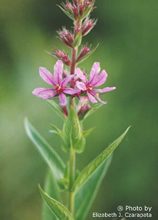

Identification:
Purple loosestrife is a perennial herb 3-7 feet tall with a dense bushy growth of 1-50 stems. Showy flowers vary from purple to magenta, possess 5-6 petals aggregated into numerous long spikes, and bloom from July to September. Leaves are opposite, nearly linear, and attached to four-sided stems without stalks.
Photos courtesy of Elizabeth Czarapata and the Minnesota DNR.
Check out the Minnesota DNR identification page, which includes species of similar appearance:
Reasons Purple Loosestrife is a Problem:
- Prefers wetlands but is tolerant of a wide range of environmental conditions, including soil types and soil pH levels.
- A single stalk can produce from 100,000 to 300,000 seeds per year and seed survival can be as high as 60-70%, plants can also spread from root and stem segments.
- Lacks natural predators such as European species of herbivorous beetles.
- Massive, homogeneous mats crowd out other plant species and can eliminate open-water habitat.
Other Info:
Purple loosestrife was introduced to the eastern United States in the 1800’s as a garden ornamental, from which it has spread to 40 states and Canada. Of Minnesota’s 87 counties 68 record a total of about 2,000 infestations. The spread of the plant is usually attributed to seed escape from gardens and nurseries, or unintentional seed transport between lakes by boat. Purple loosestrife is a prohibited exotic species in Minnesota and is illegal to possess, plant, transport, or sell. Cowling Arboretum has not experienced any major purple loosestrife infestations, but it is a species of great concern.
Cowling Arboretum Procedures for Removal:

Instances of purple loosestrife in the Arboretum have been few enough that treatment of the has been complete removal of the specimen and its roots by means of a shovel. Plants were then removed from the Arboretum to prevent resprouting or seeding. Larger infestations would be treated with herbicide application. Depending on the surrounding plant species and thickness of patches, herbicide would either be sprayed from a backpack or applied directly to cut stems, a much more time consuming process that results in less diffusion of herbicide.